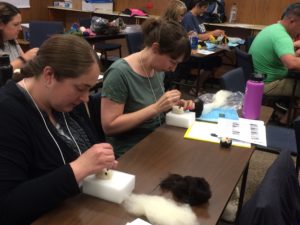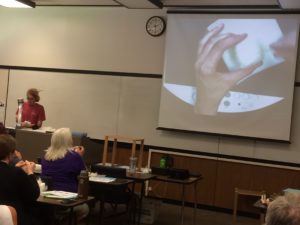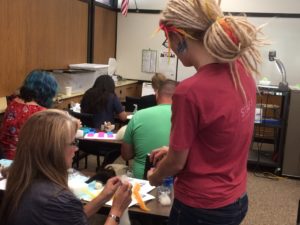Making waves
STEAM Summer Institute launches successful maiden voyage
Barbed needles stabbed felt balls with controlled gusto, creating penguins, foxes, space aliens and even a carrot.

The fabric creatures took shape in an Umpqua Community College classroom in mid-August during one of about two dozen courses comprising the first-ever STEAM Summer Institute. Presented by the Umpqua Valley STEAM Hub, the Aug. 14-18 series of professional development workshops was designed to alert educators to opportunities they may not have realized existed – tools, resources and contacts to enhance STEAM education in Douglas County. About 50 educators attended.
Participants gathered for the Aug. 17 Integrating the Arts in STEM workshop in Wayne Crooch Hall tackled the topic with a hands-on lesson provided by Talent Maker City of Talent, Oregon. As advertised, activities were geared toward illustrating how the arts (or artful innovation) can connect the disciplines of science, technology, engineering and mathematics.
Talent Maker City’s Allison French introduced Ashland artist Liza Hamilton, who shared felting materials and led educators through the process of forming small critters. These would end up as stars in a 10-second, stop-motion animation educators could later reproduce in a classroom setting. A handout described how educators could engage students by assigning them roles as a camera operator, storyboard creator, set designer, audio engineer or other technical support.
It all started with cocoon-shaped tufts of wool and barbed needles wielded to pierce holes for eyes and shape triangular ears. Class members pierced vigorously, enjoying themselves while trying to heed Hamilton’s warning: “It’s very important not to look around while you’re poking!”

Throughout the session, French and Hamilton talked about the ways educators could use the activities to deliver STEM lessons. For example, students can explore the principles of geometry as they create shapes for felt animal parts. Teachers can prompt students to discuss the properties of matter with questions such as, “How does the felt retain its structure when poked?” Students also refresh or master technological skills to create stop motion with iPads.

A handout provided samples for arts integration in topics such as math, science and health (“Visually exemplify mathematic principles such as the isosceles triangle” or “Visualize a part of the human anatomy and how it works, such as the path of blood flow through the heart.”
Arts integration was one of many subjects offered in the weeklong series. Other workshops included telling science stories with maps, astronomy and stargazing, math games, field science curriculum tools and an introduction to Oregon Connections, a web-based system to connect educators with professionals and industry.
Grace Goodson, project coordinator for the Umpqua Valley STEAM Hub, said organizers chose courses linked to project-based learning and Next Generation Science Standards. These are areas considered important by local educators, especially those seeking professional development unit credits.
“We also knew that early education was a need, and so we made sure to offer some courses with an emphasis on preschool through elementary,” Goodson said.
Most important, Goodson said, was ensuring that participants learned skills and programs they could replicate in their classrooms or other settings.
“Theory is important, but people want something they can use, and they need time to practice as well as the resources to implement the tools,” she said.
Post-session evaluations included the following comments on top takeaways:
“It’s OK not to be an expert with the technology or content – learn with students!”
“Don’t let the fear of failure keep you from trying.”
“Thinking about ways to increase student/parent participation at family nights.”
Too many to narrow down – my brain is full!”
Excellent article!